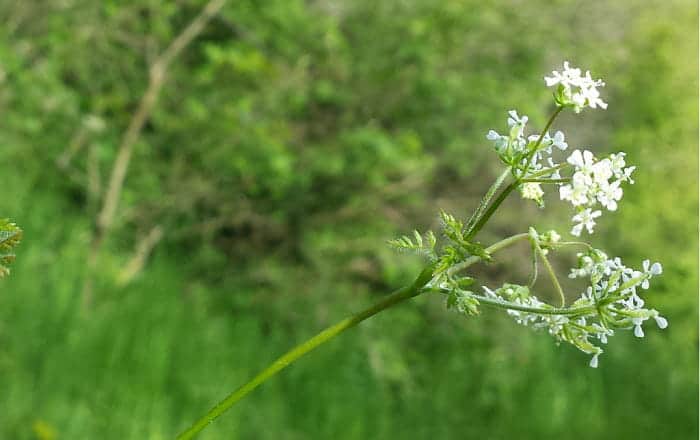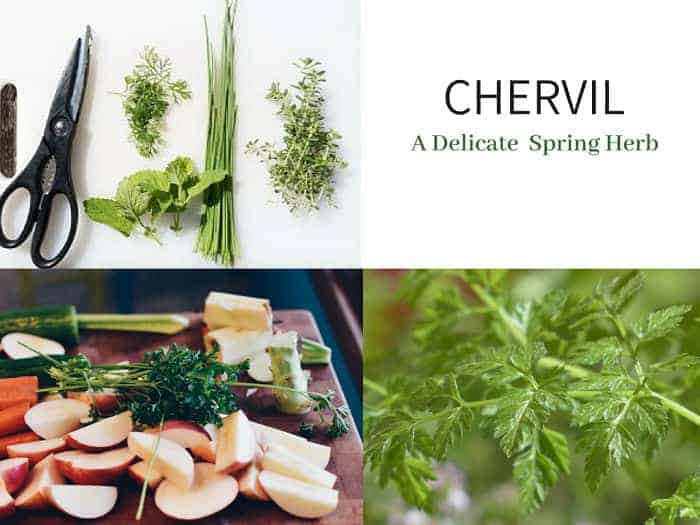Botanical Name of Chervil: Anthriscus cerefolium.
Chervil is one of the first garden herbs that can be harvest in spring and traditionally viewed as a symbol of new life.
The plant has a long history of use, and it was highly regarded as a spice and medicinal herb by the ancient Greeks, Egyptians, and Romans.
The Romans spread and introduced the plant to rest of Europe where it soon became naturalized in many areas.
In the famous writings of the author and naturalist Pliny the Elder (23-79 AD), the Natural History (Naturalis Historia) he mentions chervil where he recommends it for hiccups among other things.
Today, the herb is mostly known for its culinary uses, and since there is little scientific evidence that the plant has any unique medicinal properties, apart from its nutritional value, it is hardly ever used in modern-day herbal medicine.
Uses of Chervil in Traditional and Folk Medicine
Even though chervil is no longer considered to have any significant value as a medicinal herb, it has had its applications in folk medicine for various ailments, both externally and internally.
Just like many other plants in the Apiaceae family, the herb is regarded to have a slight digestive, diuretic, expectorant, sudorific and stimulant properties. [1]
It is said that the herb could be used as a relief for high fever and colds. It is also thought that chervil may contribute to lowering high blood pressure. [2]
Chervil was once valued as a “spring tonic” for cleansing the liver and kidneys, and as a remedy for enhancing digestion, gout, arthritis and for poor memory, and mental depression. [3]
Traditionally, the bruised leaves were used as a poultice and applied to slow-healing wounds and painful joints. As a remedy for sore and inflamed eyes, it was used in the form of an infusion as an eyewash. [4]
The herb is nutritious and rich in vitamin C, carotene, iron, calcium, and magnesium.
Culinary Uses of Chervil as a Spice Herb
Chervil has a fresh aromatic and slightly sweet flavor not unlike aniseed.
For flavoring, small quantities are best. It is an essential ingredient in the traditional French herbal mixtures “bouquet garnis” (basil, burnet, chervil, rosemary, peppercorns, savory and tarragon) and “fines herbes” (finely chopped parsley, chives, tarragon, and chervil).
It is best to use the fresh leaves as the flavor diminish rapidly if the herb is dried or cooked.
Chervil is an excellent addition to salads and it is often used for cheeses, scrambled eggs, omelets, tomato dishes, soups, sauces, stews, chicken, fish (seafood) and grilled dishes. The middle eastern vegetarian salad “tabbouleh.” often contains the leaves.
The herb is also excellent for marinade and spice butter and to add flavor to the extra-virgin olive oil.
In soups, stews, sauces and other hot dishes, the herb should be added in the final stages of the cooking to preserve the flavor.
The roots and the flowers of chervil are also edible, but apart from as a garnish, the flowers are rarely used.
It is best to cook the roots and serve them hot or cold in the form of a vegetable.
Active Ingredients and Substances
Chervil contains about 1% essential oil, with estragole and 1-allyl-2,4-dimethoxybenzene as the main constituents in addition to trace amounts of anethole (contributes to the anise flavor) and other substances.
Furthermore, the plant contains flavonoids (apiin, etc.), minerals such as calcium, iron, magnesium and potassium, vitamin C, carotene, and bitters.
The fruits contain a fatty oil with petroseline and linoleic acid. [5]
Plant Parts Used
It is the leaves that are used, mostly as a spice, but sometimes for medicinal purposes.
The leaves have a slightly peppery taste and aroma somewhat akin to anise and are harvested before the plant begins to bloom, The flowers make a beautiful garnish.
When storing the leaves for later uses, it is best to freeze them. Frozen leaves can keep for three or four months.
Growing Chevril
Although the plant is a biennial, it is usually cultivated as an annual.
Chervil is grown in the same way as parsley. The leaves are harvested after 7 to 10 weeks after sowing and can be collected until the plant produces flowers.
When growing chervil from seed, it is best to spread the seeds well and cover them with a thin layer of soil.
The seeds germinate quickly, and thinning the seedlings is essential so that they stand approximately 20 cm apart.
It is a good idea to sow chervil several times during the summer with two to three weeks apart, to ensure fresh continuous supply of the leaves.
Chervil often self-sows when it has established itself and grown in a suitable position.
The herb thrives best in nutritious, well-drained soil and lights soil that is good for moisture.
Water the plants regularly during dry periods. Also, shelter them for strong winds. The plant does not tolerate full sun well.
It is regarded to be a good companion plant for growing with carrots, radishes, dill, and coriander. If grown alongside lettuces, it is thought to offer protection from aphids, slugs, and ants.
When collecting the plants from the wild, it must be done with care as it shares some similarities with the poisonous hemlock (Conium maculatum) and fool’s parsley (Conium maculatum). [6]
Dosage and Administration
There is no established dosage for chervil for medicinal purposes.
Traditionally it is sometimes recommended for a therapeutic purpose to drink few cups a day of chervil tea.
As a tea: Add of 25 g of the finely chopped fresh leaves to a cup of boiling water. Steep for 10 minutes and then strain.
Possible Side Effects and Interactions of Chervil
There are no restrictions in using the herb as a spice in cooking,
Pregnant and lactating women should consult a professional healthcare provider before using it for medicinal purposes.
Avoid using in those with known allergies or sensitivity to chervil, or other members of the Apiaceae family. [7]
Other Common Names
- Garden chervil
- French parsley
- Kjørvel (Norwegian)
- Kørvel (Danish)
- Kerbel (German)
- Cerfeuil (French)
- Perfolio (Spanish)
- Kerfill (Icelandic)
- Gårdegearvil (Swedish)
- Maustekirveli (Finnish)
- San-lo-po (Chinese)
Habitat
Chervil is native to Central Asia (the Caucasus, from Iran to southern Russia.
Today, chervil is a favorite garden plant, and it is cultivated in Europe, North America and other places around the world.
Plant Description
Chervil is an annual plant that belongs to the celery, carrot or parsley family. (Apiaceae) It can grow up to 30-70 cm (12–30 inches) high and 20-30 cm (8 to 12 inches wide).
The straight stems are thin, and the light green finely divided curly tripinnate leaves are similar to those of parsley.
The inconspicuous white flowers form small umbels. The root is long and pointed and smells of anise. The fruits are glossy black, 9.8 mm long with a long, narrow beak.
Supporting References
[1] Reader’s Digest: Magic and Medicine of Plants. Reader’s Digest 1986
[2] ScienceAlert – A Multifunctional Miraculous Nutritional Herb
[3] Hoffmann, David: The New Holistic Herbal. Boston. Element Books Ltd. 1990.
[4] Bown, Deni: The Royal Horticultural Society New Encyclopedia of Herbs and Their Uses. London, England. Dorling Kindersley 2002.
[5] Obanis.org – NOBANIS –Invasive Alien Species Fact Sheet
[6] Bown, Deni: Herbal. The Essential Guide to Herbs for Living. London, England. Pavilion Books Limited 2003.
[7] Elias, Jason & Shelagh Ryan Masline: The A to Z Guide to Healing Herbal Remedies. New York. Dell Publishing 1995.
Thordur Sturluson
Latest posts by Thordur Sturluson (see all)
- What is the Difference Between Hemp and Marijuana? - June 3, 2019



Leave a Reply